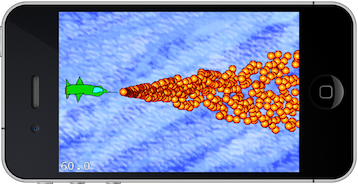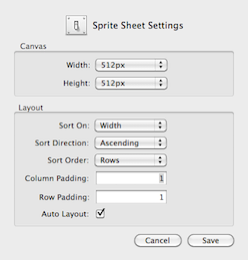《Learn IPhone andiPad Cocos2d Game Delevopment》第6章(原文中部分无关紧要的内容没有进行翻译)。
一、 CCSpriteBatchNode
在屏幕上贴图时,图形硬件需要经过准备、渲染、清除等步骤。每次贴图都会重复这个过程。如果图形硬件能事先知道有一组拥有相同纹理的Sprite需要渲染,则这个过程会被简化。比如,一组Sprite的准备和清除动作总共只需要执行一次。
下图的例子使用了CCSpriteBacthNode。屏幕上同时有几百颗子弹飞过。如果一次只渲染一颗,那么帧率马上降到85%。使用CCSpriteBatchNode,可以避免这种情况:

通常我们这样创建一个CCSprite:
CCSprite*sprite=[CCSprite spriteWithFile:@”bullet.png”];
[selfaddChild:sprite];
而使用CCSpriteBatchNode则需要修改为:
CCSpriteBatchNode*batch=[CCSpriteBatchNode batchNodeWithFile:@”bullet.png”];
[selfaddChild:batch];
for(inti=0;i<100;i++){
CCSprite* sprite=[CCSpritespriteWithFile:@”bullet.png”];
[batch addChild:bullet];
}
注意,CCSpriteBatchNode需要一个图片文件名作为参数,哪怕它根本用不着这个图片(进行显示)。可以把它看做是一个Layer,你可以用它来加入一些CCSprite节点。由于它使用了一个图片文件作为构造参数,所以在后面加入的CCSprite中必须使用相同的文件作为构造参数,否则会导致如下错误:
SpriteBatches[13879:207]*** Terminating app due to uncaught exception"NSInternalInconsistencyException", reason: "CCSprite is not using the sametexture id"
当采用相同纹理的CCSpite越多,则采用CCSpriteBatchNode的好处越明显。
但这有一个限制,所有的CCSprite节点都会位于同一个Z坐标(深度)上。如果子弹是“击穿”敌人并向后飞,你得使用两个Z轴不同的CCSpriteBatchNode。
另外一个限制是,CCSpriteBatchNode和加入其中的CCSprite必须使用相同的贴图。这一点在使用TextureAtlas时尤其显得重要。一个Texture Atlas可以画多个不同的图片,并且这些图片使用同一个CCSpriteBatchNode,以提高渲染速度。
Z轴的问题可以通过指定CCSpriteBatchNode中单个CCSprite的Z值来解决。如果你所有的图片都放到了一个TextureAtlas(纹理集),则你完全可以只使用一个CCSpriteBatchNode。
把CCSpriteBatchNode看成一个简单的CCLayer,它只接受使用相同图片的CCSprite,这样,你就知道怎么用它了。
在下面代码中,隐藏有一个致命的陷阱:
-(id)init{
If ((self = [superinitWithFile:@"ship.png"])) {
[self scheduleUpdate];
}
return self;
}
由于-(id)init方法是默认的初始化方法,它会被其他初始化方法比如initWithFile调用。在-(id)init方法中调用了[super initWithFile…]方法,[super initWithFile…]会调用[super init], 该类覆盖了-(id)init方法,于是又会调用-(id)init方法,无限循环。
解决办法是修改方法名,比如修改为-(id)initWithShipImage。
这个教训告诉我们,在默认初始化方法-(id)init中,除了[superinit]之外,永远不要调用其他东西(其他的初始化方法)。如果你必须在初始化方法中调用[super initWith…]方法,你应当把方法名命名为initWith…。
二、示例代码
1、ship类
#import <Foundation/Foundation.h>
#import "cocos2d.h"
@interface Ship : CCSprite
{
}
+(id) ship;
@end
#import "Ship.h"
#import "Bullet.h"
#import "GameScene.h"
@interface Ship (PrivateMethods)
-(id) initWithShipImage;
@end
@implementation Ship
+(id) ship
{
return [[[selfalloc] initWithShipImage] autorelease];
}
-(id) initWithShipImage
{
if ((self = [superinitWithFile:@"ship.png"]))
{
[selfscheduleUpdate];
}
returnself;
}
-(void) dealloc
{
[superdealloc];
}
-(void) update:(ccTime)delta
{
[[GameScenesharedGameScene] shootBulletFromShip:self];
}
@end
ship类很简单,除了update方法。该方法调用了GameScene的shootBulletFromShip方法外([GameSceneshareGameScene]实际上只是获取GameScene 的单实例)。
2、GameScene类
#import <Foundation/Foundation.h>
#import "cocos2d.h"
#import "Ship.h"
typedefenum
{
GameSceneNodeTagBullet = 1,
GameSceneNodeTagBulletSpriteBatch,
} GameSceneNodeTags;
@interface GameScene : CCLayer
{
intnextInactiveBullet;
}
+(id) scene;
+(GameScene*) sharedGameScene;
-(void) shootBulletFromShip:(Ship*)ship;
@property (readonly) CCSpriteBatchNode*bulletSpriteBatch;
@end
#import "GameScene.h"
#import "Ship.h"
#import "Bullet.h"
@interface GameScene(PrivateMethods)
-(void) countBullets:(ccTime)delta;
@end
@implementation GameScene
static GameScene*instanceOfGameScene;
+(GameScene*) sharedGameScene
{
NSAssert(instanceOfGameScene != nil, @"GameSceneinstance not yet initialized!");
returninstanceOfGameScene;
}
+(id) scene
{
CCScene *scene = [CCScenenode];
GameScene *layer = [GameScenenode];
[scene addChild: layer];
return scene;
}
-(id) init
{
if ((self = [superinit]))
{
instanceOfGameScene = self;
CGSize screenSize = [[CCDirectorsharedDirector] winSize];
CCColorLayer* colorLayer = [CCColorLayerlayerWithColor:ccc4(255, 255, 255, 255)];
[selfaddChild:colorLayer z:-1];
CCSprite* background = [CCSpritespriteWithFile:@"background.png"];
background.position = CGPointMake(screenSize.width / 2, screenSize.height / 2);
[selfaddChild:background];
Ship* ship = [Shipship];
ship.position = CGPointMake(ship.texture.contentSize.width / 2, screenSize.height / 2);
[selfaddChild:ship];
CCSpriteBatchNode* batch = [CCSpriteBatchNodebatchNodeWithFile:@"bullet.png"];
[selfaddChild:batch z:1tag:GameSceneNodeTagBulletSpriteBatch];
for (int i = 0; i < 400; i++)
{
Bullet* bullet = [Bulletbullet];
bullet.visible =NO;
[batch addChild:bullet];
}
[selfschedule:@selector(countBullets:) interval:3];
}
returnself;
}
-(void) dealloc
{
instanceOfGameScene = nil;
//don"t forget to call "super dealloc"
[superdealloc];
}
-(void) countBullets:(ccTime)delta
{
CCLOG(@"Number ofactive Bullets: %i", [self.bulletSpriteBatch.childrencount]);
}
-(CCSpriteBatchNode*) bulletSpriteBatch
{
CCNode* node = [selfgetChildByTag:GameSceneNodeTagBulletSpriteBatch];
NSAssert([node isKindOfClass:[CCSpriteBatchNodeclass]], @"not aCCSpriteBatchNode");
return (CCSpriteBatchNode*)node;
}
-(void) shootBulletFromShip:(Ship*)ship
{
CCArray* bullets = [self.bulletSpriteBatchchildren];
CCNode* node = [bullets objectAtIndex:nextInactiveBullet];
NSAssert([node isKindOfClass:[Bulletclass]], @"not abullet!");
Bullet* bullet = (Bullet*)node;
[bullet shootBulletFromShip:ship];
nextInactiveBullet++;
if (nextInactiveBullet >= [bullets count])
{
nextInactiveBullet = 0;
}
}
@end
现在你应该看到了,在init方法中使用CCSpriteBatchNode加入了400颗子弹(被设置为不可见了)。然后在接下来的shootBulletFromShip方法(在ship的update方法中调用)中,依次调用每一颗子弹的shootBulletFromShip方法。
3、Bullet类
#import <Foundation/Foundation.h>
#import "cocos2d.h"
#import "Ship.h"
@interface Bullet : CCSprite
{
CGPointvelocity;
floatoutsideScreen;
}
@property (readwrite, nonatomic) CGPoint velocity;
+(id) bullet;
-(void) shootBulletFromShip:(Ship*)ship;
@end
#import "Bullet.h"
@interface Bullet(PrivateMethods)
-(id) initWithBulletImage;
@end
@implementation Bullet
@synthesize velocity;
+(id) bullet
{
return [[[selfalloc] initWithBulletImage] autorelease];
}
-(id) initWithBulletImage
{
if ((self = [superinitWithFile:@"bullet.png"]))
{
}
returnself;
}
-(void) dealloc
{
[superdealloc];
}
// Re-Uses the bullet
-(void) shootBulletFromShip:(Ship*)ship
{
float spread = (CCRANDOM_0_1() - 0.5f) * 0.5f;
velocity = CGPointMake(1, spread);
outsideScreen = [[CCDirectorsharedDirector] winSize].width;
self.position = CGPointMake(ship.position.x + ship.contentSize.width * 0.5f, ship.position.y);
self.visible = YES;
[selfscheduleUpdate];
}
-(void) update:(ccTime)delta
{
self.position = ccpAdd(self.position, velocity);
if (self.position.x > outsideScreen)
{
self.visible = NO;
[selfunscheduleAllSelectors];
}
}
@end
shootBulletFromShip方法实现了子弹的射击。Spread变量计算了一个扩散值,使从飞船中射出的子弹有1/2的机率会向上/下两边扩散。Velocity是一个每帧移动的位置偏移量。然后设置子弹的初始位置位于飞船右边。在把子弹可视状态设置为显示后,调度运行update方法(每帧调用一次)。
在update方法中,让子弹移动velocity的偏移量。这种方式,比CCMoveXX方法效率更高一些。而且这里用了一个技巧,当子弹飞出屏幕后,我们并没有立即将Bullet对象清除(为了节省资源),而是子弹设置为不可视缓存起来,方便再次使用以提高程序性能。出于这个原因,我们在GameScene类中设计了一个nextInactiveBullet变量,以此来记录已经使用掉(射出去)的子弹(设置为可视的子弹)。等所有子弹都射出去以后,nextInactiveBullet重置为0。
三、增加角色动画
以下代码为ship对象增加角色动画。Ship对象的角色动画是5张连续的帧图像,以表现飞船尾部不断喷射并变化的火焰。
-(id) initWithShipImage
{
if ((self = [superinitWithFile:@"ship.png"]))
{
// 把5张图片装入动画帧数组
NSMutableArray* frames = [NSMutableArrayarrayWithCapacity:5];
for (int i = 0; i < 5; i++)
{
NSString* file = [NSStringstringWithFormat:@"ship-anim%i.png", i];
// 使用贴图缓存构造2D贴图
CCTexture2D* texture = [[CCTextureCachesharedTextureCache] addImage:file];
CGSize texSize = texture.contentSize;
CGRect texRect = CGRectMake(0, 0, texSize.width, texSize.height);
// 用2D贴图构造动画帧
CCSpriteFrame* frame = [CCSpriteFrameframeWithTexture:texture rect:texRect offset:CGPointZero];
// 把动画帧放入数组
[frames addObject:frame];
}
// 用动画帧数组构造动画对象,帧率:0.08秒/帧,标识名:move
CCAnimation* anim = [CCAnimationanimationWithName:@"move"delay:0.08fframes:frames];
// 如果你把anim存储到CCSprite,则可以通过名称move来访问CCAnimation
//[self addAnimation:anim];
// 构造Action:无限重复
CCAnimate* animate = [CCAnimateactionWithAnimation:anim];
CCRepeatForever* repeat = [CCRepeatForeveractionWithAction:animate];
[selfrunAction:repeat];
[selfscheduleUpdate];
}
returnself;
}
为求简便,上面的代码我们也可以封装为一个新的类别Category。
1、类别AnimationHelper
利用OC中的Category,我们可以扩展CCAnimation类。Category提供了一种不需要修改类的源代码即可为类增加新方法的途径(有点象AOP?),但它不能增加新的成员变量。下面的代码为CCAnimation增加了一个Category,名为Helper(新建Class,名为CCAnimationHelper.h):
#import <Foundation/Foundation.h>
#import "cocos2d.h"
@interface CCAnimation (Helper)
+(CCAnimation*) animationWithFile:(NSString*)name frameCount:(int)frameCount delay:(float)delay;
+(CCAnimation*) animationWithFrame:(NSString*)frame frameCount:(int)frameCount delay:(float)delay;
@end
#import "CCAnimationHelper.h"
@implementation CCAnimation (Helper)
// 通过图片文件名创建CCAnimation对象.
+(CCAnimation*) animationWithFile:(NSString*)name frameCount:(int)frameCount delay:(float)delay
{
//把前面的代码移到这里来了
NSMutableArray* frames = [NSMutableArrayarrayWithCapacity:frameCount];
for (int i = 0; i < frameCount;i++)
{
NSString* file = [NSStringstringWithFormat:@"%@%i.png", name, i];
CCTexture2D* texture = [[CCTextureCachesharedTextureCache] addImage:file];
CGSize texSize = texture.contentSize;
CGRect texRect = CGRectMake(0, 0, texSize.width, texSize.height);
CCSpriteFrame* frame = [CCSpriteFrameframeWithTexture:texture rect:texRect offset:CGPointZero];
[framesaddObject:frame];
}
return [CCAnimationanimationWithName:namedelay:delayframes:frames];
}
// 通过sprite frames创建CCAnimation.
+(CCAnimation*) animationWithFrame:(NSString*)frame frameCount:(int)frameCount delay:(float)delay
{
//未实现
returnnil;
}
@end
现住,在Ship类的初始化方法里,可以通过CCAnimation的类别Helper这样简单地创建动画对象了:
-(id) initWithShipImage
{
if ((self = [superinitWithFile:@"ship.png"]))
{
// 使用类别Helper来创建动画对象
CCAnimation* anim = [CCAnimationanimationWithFile:@"ship-anim"frameCount:5delay:0.08f];
// 创建Action:无限循环播放动画
CCAnimate* animate = [CCAnimateactionWithAnimation:anim];
CCRepeatForever* repeat = [CCRepeatForeveractionWithAction:animate];
[selfrunAction:repeat];
[selfscheduleUpdate];
}
returnself;
}
四、 Texture Atlas 贴图集(或译作纹理集)
1、定义
贴图集Texture Atlas仅仅是一张大的贴图。通过使用CCSpriteBatchNode,你可以一次性渲染所有的图片。使用TextureAtlas不但节约了内存也提升了性能。
贴图的大小(宽和高)总是2的n次方——例如1024128或256512。由于这个规则,贴图尺寸有时候是大于图片的实际尺寸的。例如,图片大小140600,当加载到内存时,贴图尺寸是2561024。这显然是一种内存浪费,尤其是你有几个这样的单独的Texture时。
因此有了Texture Atlas的概念。它是一张包含了多个图片的图片,并且它的尺寸已经是对齐的。所谓对齐,即是根据前面提到的那个规则,指它的长和宽都已经是2的n次方。贴图集每一个角色帧(spriteframe)都定义为贴图集中的一部分(一个矩形区域)。这些角色帧的CGrect则定义在单独的一个.plist文件里。这样cocos2d就可以从一张大的贴图集中单独渲染某个指定的角色帧。
2、Zwoptex
Zwoptex是一个2D贴图工具,付费版需要$24.95。有一个7天的试用版,下载地址http://zwoptexapp.com。但Zwoptex提供了一个flash版,没有时间限制:http://zwoptexapp.com/flashwersion,也基本够用(仅仅有一些限制,比如2048*2048贴图限制,角色旋转等)。
如果你不想试用Zwoptex,那么有一个可以替换的工具是TexturePacker:
这里以Zwoptex 0.3b7版本为例(这个是免费版)。打开Zwoptex,默认是一个叫做Untitled的空白画布。选择菜单:SpriteSheet ——>Import Sprites,会弹出文件选择对话框,选择你需要的角色帧图片文件,点击import,于是所有的图片会导入到Zwoptex。
选择菜单:Sprite Sheet——>Settings,会弹出布局窗口:

你可以更改设置,包括画布大小,排序规则、行间距、列间距等,目的是用最小的贴图集容纳全部所需的图片。然后点击save去应用。
注意,除非单独为3GS、iPad和iPhone4开发,否则不要使用20482048的画布尺寸,因为老的型号最大只支持10241024。
改变画布大小时要当心,因为有时候图片会叠在一起——由于空间不足。
建议不要手动更改图片(如移动、旋转),因为这个版本并不支持,它是自动布局的。
Zwoptex会自动截掉图片中透明边沿,所以本来一样大小的图片在Zwoptex中会显得大小不一。

不用担心,cocos2d会自动计算这些误差并正确显示(不用担心,这些数据都记载在.plist里)。
点击File——>save菜单,编辑结果保存为.zss文件格式(Zwoptex格式)。
点击Sprite Sheet——>Export——>Texture,编辑结果保存为.png格式。
点击Sprite Sheet——>Export——>Cordinates,编辑结果保存为.plist格式。
后两者,正是cocos2d所需要的。
3、Cocos2d中使用贴图集
首先,将Zwoptex生成的.png和.plist文件加入到项目的Resource组中。然后在代码中使用贴图集:
-(id) initWithShipImage
{
//用CCSpriteFrameCache加载贴图集,用.plist文件而不是.png文件做参数
CCSpriteFrameCache* frameCache = [CCSpriteFrameCachesharedSpriteFrameCache];
[frameCache addSpriteFramesWithFile:@"ship-and-bullet.plist"];
//从贴图集中加载名为ship.png的sprite,注意ship.png是.plist中定义的key,而不是真正意义的文件名
if ((self = [superinitWithSpriteFrameName:@"ship.png"]))
{
// 从贴图集中加载sprite帧,注意用.plist中的key值做参数而非文件名
NSMutableArray* frames =[NSMutableArray arrayWithCapacity:5];
for (inti = 0; i < 5; i++)
{
NSString* file = [NSString stringWithFormat:@"ship-anim%i.png", i];
CCSpriteFrame* frame = [frameCache spriteFrameByName:file];
[frames addObject:frame];
}
CCAnimation* anim = [CCAnimationanimationWithName:@"move"delay:0.08fframes:frames];
CCAnimate* animate = [CCAnimateactionWithAnimation:anim];
CCRepeatForever* repeat = [CCRepeatForeveractionWithAction:animate];
[selfrunAction:repeat];
[selfscheduleUpdate];
}
returnself;
}
[CCSpriteFrameCachesharedSpriteFrameCache]是一个单例对象,其 addSpriteFramesWithFile 方法用于加载贴图集(需要以.plist文件名作为参数)。对于大文件贴图集(超过512*512),加载过程可能会花费数秒,应当在游戏开始前就加载。
CCSprite的initWithSpriteFrameName方法可以从贴图集中获取贴图,并设置Sprite的显示图片,但它需要以贴图集(.plist)中的帧名(framename,实际上是中的一个)为参数。
当然,如果要从贴图集中得到一个帧,可以用CCSpriteFrameCache的spriteFrameByName方法。这同样需要用贴图集中的帧名为参数。
如果你加载了多个贴图集,但只要名为ship.png的帧只有1个,那么cocos2d就可以找到正确贴图的。
其他代码没有任何改变。但出现了一个奇怪的现象:飞船的位置莫名其妙地向屏幕中心靠近了一点,尽管不是很明显。这个问题很容易解决,之前Ship的初始化代码是这样的:
Ship* ship = [Shipship];
ship.position = CGPointMake(ship.texture.contentSize.width / 2, screenSize.height / 2);
[selfaddChild:ship];
这个地方需要改变:
ship.position = CGPointMake(ship.contentSize.width / 2, screenSize.height / 2);
问题解决了。导致这个现象的原因是,ship对象的texture的contentSize要比ship对象的contentSize大(Ship的Texture现在用的是贴图集——具体说就是ship-and-bullet.png 这张图,尺寸为256256,而原来的ship.png才12864)。
4、修改CCAnimation类别Helper
现在是实现类别Helper中的animationWithFrame方法的时候了:
+(CCAnimation*)animationWithFrame:(NSString*)frame frameCount:(int)frameCount delay:(float)delay
{
//构造一个frame数组
NSMutableArray* frames = [NSMutableArray arrayWithCapacity:frameCount];
//通过CCSpriteFrameCache从贴图集中加载frame,并将frame加到数组中
for (inti = 0; i < frameCount; i++)
{
NSString* file = [NSStringstringWithFormat:@"%@%i.png", frame, i];
CCSpriteFrameCache* frameCache = [CCSpriteFrameCachesharedSpriteFrameCache];
CCSpriteFrame* frame = [frameCache spriteFrameByName:file];
[framesaddObject:frame];
}
//用frame数组构建animation对象并返回
return [CCAnimationanimationWithName:frame delay:delayframes:frames];
}
现在,可以修改ship类中initWithShipImage方法,把CCAnimation的初始化修改为:
CCAnimation* anim = [CCAnimationanimationWithFrame:@"ship-anim"frameCount:5delay:0.08f];
5、弱水三千,只取一瓢饮
只要你愿意,你可以把所有游戏图片都加到一个贴图集里。用3个1024*1024的贴图集跟用20个更小的贴图集效率更高。
对于程序员而言,应当把代码“分离”成不同的逻辑组件。于此不同,对于贴图集来说,我们的目标就是尽可能多地把图片放到一个贴图集里,尽可能降低内存空间的浪费。
用一个贴图集放入玩家图片,用另外的贴图集放怪物A、B、C的图片——这好像更符合逻辑些,但这仅仅有助于你有大量的图片,而且每次你只是有选择地加载一部分图片的时候。
当你的图片只需要3-4个1024*1024贴图集的时候,你应当把所有图片只放在这些贴图集里进行预加载。这需要12-16MB的内存。程序代码和其他资源如音频则不会占用这么多内存,你可以把这些贴图集都保留在内存,这样哪怕只有128MBRAM的老IOS设备也可以承受。
如果超过这个内存,就应该采取特别的策略了。比如,可以把游戏图片进行分类,并且只在当前地图中加载必要的贴图集。这可以减少地图加载时的延时。
因为cocos2d会自动缓存所有图片,需要一种卸载贴图的机制。绝大部分情况下你可以使用cocos2d提供的:
[[CCSpriteFrameCachesharedSpriteFrameCache]removeUnusedSpriteFrames];
[[CCTextureCachesharedTextureCache] removeUnusedTextures];
显然应当在某些贴图不再使用的时候调用这些方法。比如转场景完成后。游戏正在进行时就不行了。注意,仅仅在新场景初始化结束后,前面的场景才会被deallocated。意即在一个Scenen的初始化方法中你不能调用removeUnusedxxx方法——除非你在两个scene转换中使用了第5章的LoadingScene类,这样你要扩展LoadingScene使它在加载新场景替时remove所有未使用的贴图。
如果要绝对清除所有内存中的贴图以加载新的贴图,应当使用:
[CCSpriteFrameCachepurgeSharedSpriteFrameCache];
[CCTextureCachepurgeSharedTextureCache];
6、美工和艺术
图片的编辑你可以使用免费软件Searshore:http://seashore.sourceforge.net
对于动画和位图,你可以使用Pixen:http://opensword.org/Pixen,这是一个简单易用和强大的动画编辑工具。
如果你想自己制作音乐音效,可以使用Mac自带的GarageBand。插上一只麦克风开始记录一些声音,花几分钟编辑并在任何适当的地方使用这些声音。如果不想自己制作声效,也可以从网上搜索一些免费或便宜的音频,例如www.soundsnap.com或者类似网站。
警告:对于使用源自互联网的音频和图片要尤其小心。你可以下载到一些“免费”的资源用于早期的游戏制作。但简单的“免费”并不意味着你可以再分发这些文件,或者用于商业用途,例如在苹果商店中销售。除非获得作者特别的授权或者这些资源附有一个正式的协议。